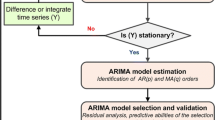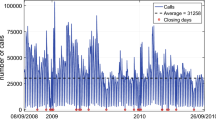Abstract
This paper describes a model that can forecast the daily number of occupied beds due to emergency admissions in an acute hospital. Out of sample forecasts 32 day days in advance, have an RMS error of 3% of the mean number of beds used for emergency admissions. We find that the number of occupied beds due to emergency admissions is related to both air temperature and PHLS data on influenza like illnesses. We find that a period of high volatility, indicated by GARCH errors, will result in an increase in waiting times in the A&E Department. Furthermore, volatility gives more warning of waiting times in A&E than total bed occupancy.
Similar content being viewed by others
References
A. Bagust, M. Place and J.W. Posnett, Dynamics of bed use in accommodating emergency admissions: Stochastic simulation model, The BMJ 319 (1999) 155-158.
T. Bollerslev, Generalized autoregressive conditional heteroscedasticity, Journal of Econometrics 31 (1986) 307-327.
G.E.H. Box, G.M. Jenkins and G.C. Reinsel, Time Series Analysis, Forecasting and Control, 3rd Ed. (Prentice-Hall, Englewood Cliffs, NJ, 1994).
C. Chatfield, Time Analysis of Time Series, 5th Ed. (Chapman & Hall, London, 1996).
A. Davison and S. Bowhay, Quantity surveying, Health Service Journal (30 September 1999) 24-26.
R.J. Delfino, A.M. Murphey-Moulten, R.T. Burnett and M.R. Becklake, Effects of air pollution on emergency visits for respiratory illness in Montreal, Quebec, American Journal of Respiratory and Critical Care Medicine 155(2) (1997) 568-576.
W. Enders, Applied Econometric Time Series (Wiley, New York, 1995).
R.F. Engel, Autoregressive conditional heteroscedasticity with estimation of the variance in United Kingdom inflation, Econometrica 50 (1982) 987-1007.
R.D. Farmer and J. Emami, Models for forecasting hospital bed requirements in the acute sector, Journal Epidemiological Community Health 44(4) (1990) 307-312.
R. Gilchrist, Some aspects of modeling operational problems in the National Health Service, The Statistician 34(2) (1985) 209-214.
C. Handy, Understanding Organizations (Penguin, London, 1993).
B. Hanratty and M. Robinson, Coping with winter bed crisis, The BMJ 319 (1999) 1511-1512.
M. Holt and S. Aradhyula, Price risk in supply equations: An application of GARCH time-series models in the us broiler market, Southern Economic Journal 57 (1990) 230-242.
D.C. Lane, C. Monefeldt and J.V. Rosehead, Looking in the Wrong Places: A Systems Dynamic Study of an Accident and Emergency Department (The London School of Economics and Political Science, London, 1998).
P.C. Milner, Forecasting the demand on accident and emergency departments in health districts in the Trent region, Statistics in Medicine 10 (1988) 1061-1072.
P.C. Milner, Ten year follow-up of arima forecasts of attendance at accident and emergency departments in the Trent region, Statistics in Medicine 16 (1997) 2117-2125.
National Audit Office, Inpatient Admissions and Bed Management in NHS Acute Hospitals (The Stationery Office, London, 2000).
J. Noh, R.F. Engel and A. Kane, Forecasting volatility and option prices of the S&P 500 index, Journal of Derivatives (1994) 16-30.
P.A. Riseborough and M. Walter, Management in Health Care (Wright, London, 1988).
R.H. Shumway, A.S. Azari and Y. Pawita, Modeling mortality fluctuations in Los Angeles as functions of pollution and weather effects, Environmental Research 45(2) (1988) 224-241.
W.E. Sterk and F.G. Shryock, Modern methods improve hospital forecasting, Healthcare Finance Manager 41(3) (1987) 96-98.
M. Tullius, De Divinatione, in: Cicero, De Senectute, De Amicitia, De Divinatione, ed. W.A. Falconer (Harvard University Press, Cambridge, MA, 1923).
J. Warden, Health secretary reports on winter bed crisis, The BMJ 318 (1999) 145.
Author information
Authors and Affiliations
Corresponding author
Rights and permissions
About this article
Cite this article
Jones, S.A., Joy, M.P. & Pearson, J. Forecasting Demand of Emergency Care. Health Care Management Science 5, 297–305 (2002). https://doi.org/10.1023/A:1020390425029
Issue Date:
DOI: https://doi.org/10.1023/A:1020390425029




